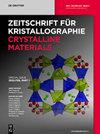Quantum transport and microwave scattering on fractal lattices
IF 2.7
4区 材料科学
Q3 CRYSTALLOGRAPHY
Zeitschrift Fur Kristallographie-Crystalline Materials
Pub Date : 2022-03-24
DOI:10.1515/zkri-2021-2070
引用次数: 1
Abstract
Abstract Studying the wave-particle nature of electrons in different ways has lead to many fundamental discoveries. Particularly, the dimensionality dependent electronic behavior in the Luttinger Liquid (1D), Quantum Hall (2D) and non-interacting Fermi Liquid (3D) regimes have already revolutionized our understanding of the mechanisms behind quantum electronics. In this work, the theoretical and experimental studies focus on the non-integer dimension represented by an sp2-carbon-based Sierpinski triangular structure with a 1.58D space occupancy. In the tight-binding approach, the spectral distribution of electronic states of such a structure exhibits distinct peak patterns, which are well-separated by gaps. Through quantum transport simulation, the conductance of electrons in 1.58D was studied. Both delocalized, conducting and localized, non-conducting states identified, which differ from the established features of both the fully 2D graphene sheet and 1D carbon nanotubes. In microwave scattering measurements on an adequate experimental setting and the respective simulations on the Sierpinski triangle, the obtained diffraction patterns showed interesting peculiarities such as a reduced number of minima and magic angle, next to diffraction regions of high and low intensity, as well as forbidden regions. The fractal geometry of the structure affects the propagation of waves by manipulating the way they interact with each other which results in structural metamaterial-like interference characteristics, decreasing or amplifying the transmitted or reflected signals, or blocking the transport completely.分形晶格上的量子输运和微波散射
摘要以不同的方式研究电子的波粒性质,导致了许多基本的发现。特别是,Luttinger Liquid(1D)、量子霍尔(2D)和非相互作用费米液体(3D)体系中的维度相关电子行为已经彻底改变了我们对量子电子学背后机制的理解。在这项工作中,理论和实验研究集中在由空间占用率为1.58D的sp2碳基Sierpinski三角形结构表示的非整数维度上。在紧密结合方法中,这种结构的电子态的光谱分布表现出不同的峰值模式,这些模式被间隙很好地分开。通过量子输运模拟,研究了1.58D中电子的电导。确定了离域导电和局域非导电状态,这与完全2D石墨烯片和1D碳纳米管的既定特征不同。在适当的实验环境下进行的微波散射测量和对Sierpinski三角形的相应模拟中,所获得的衍射图案显示出有趣的特性,例如在高强度和低强度的衍射区域以及禁区旁边,最小值和魔角的数量减少。结构的分形几何通过操纵波相互作用的方式影响波的传播,从而产生类似结构超材料的干扰特性,减少或放大传输或反射信号,或完全阻断传输。
本文章由计算机程序翻译,如有差异,请以英文原文为准。
求助全文
约1分钟内获得全文
求助全文
来源期刊

Zeitschrift Fur Kristallographie-Crystalline Materials
CRYSTALLOGRAPHY-
CiteScore
2.00
自引率
16.70%
发文量
55
期刊介绍:
Zeitschrift für Kristallographie – Crystalline Materials was founded in 1877 by Paul von Groth and is today one of the world’s oldest scientific journals. It offers a place for researchers to present results of their theoretical experimental crystallographic studies. The journal presents significant results on structures and on properties of organic/inorganic substances with crystalline character, periodically ordered, modulated or quasicrystalline on static and dynamic phenomena applying the various methods of diffraction, spectroscopy and microscopy.
 求助内容:
求助内容: 应助结果提醒方式:
应助结果提醒方式:


